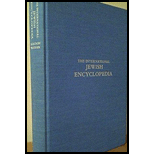
Concept explainers
To determine: The shortest route from node 1 to each of the other six nodes.
Explanation of Solution
Given diagram:
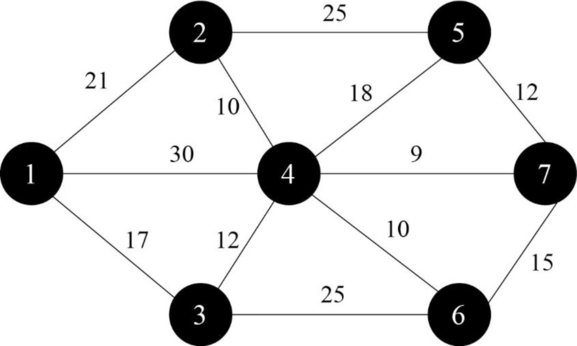
Determine the shortest route:
Step 1:
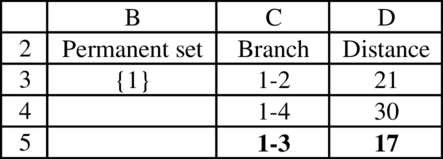
The initial node from the given diagram is Node 1. In the above table, nodes from Node 1 should be considered. While comparing the distance of each branch, 1-3 has the minimum distance. Hence, it was chosen. The diagram for the above table is as follows:
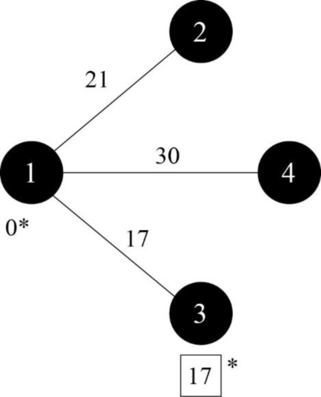
Step 2:
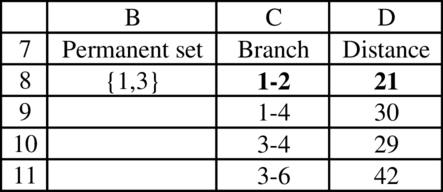
In the above table, nodes from Node 1 and Node 3 (as Node 3 was chosen in step 1) should be considered. However, the chosen branch should not be considered again. While comparing the distance of each branch, 1-2 has the minimum distance. Hence, it was chosen. The diagram for the above table is as follows:
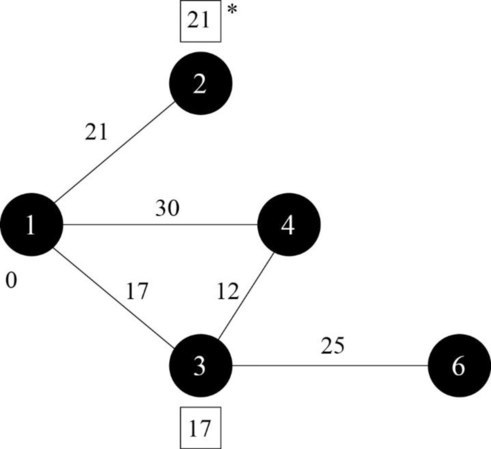
Step 3:
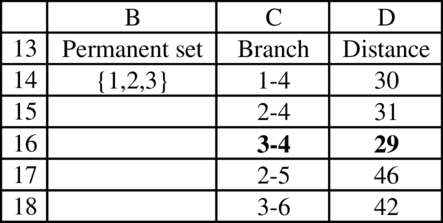
In the above table, nodes from Node 1, Node 3, and Node 2 (as Node 2 was chosen in step 2) should be considered. However, the chosen branch should not be considered again. While comparing the distance of each branch, 3-4 has the minimum distance. Hence, it was chosen. The diagram for the above table is as follows:
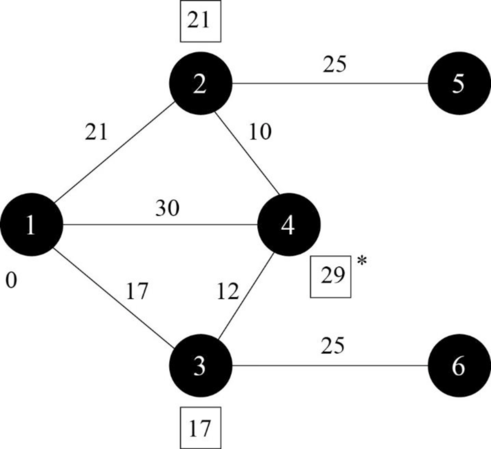
Step 4:
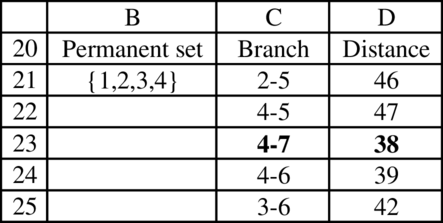
In the above table, nodes from Nodes 1, 3, 2, and 4 (as Node 4 was chosen in step 3) should be considered. However, the chosen branch should not be considered again. While comparing the distance of each branch, 4-7 has the minimum distance. Hence, it was chosen. The diagram for the above table is as follows:
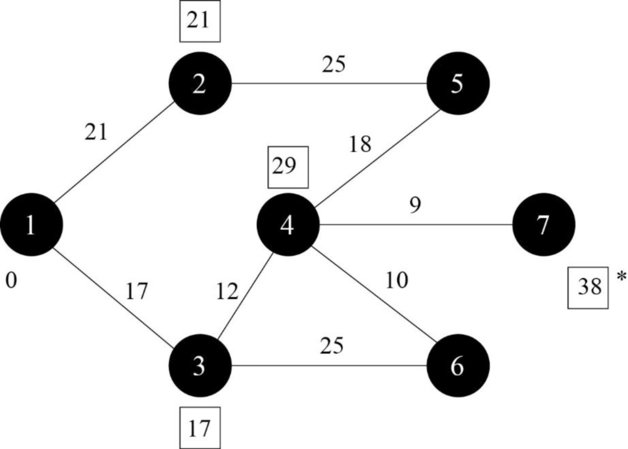
Step 5:
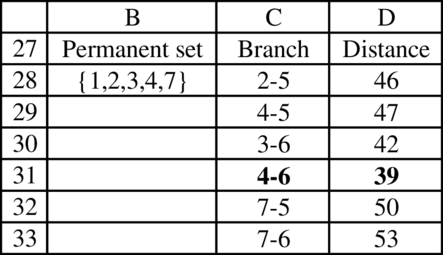
In the above table, nodes from Nodes 1, 3, 2, 4, and 7 (as Node 7 was chosen in step 4) should be considered. However, the chosen branch should not be considered again. While comparing the distance of each branch, 4-6 has the minimum distance. Hence, it was chosen. The diagram for the above table is as follows:
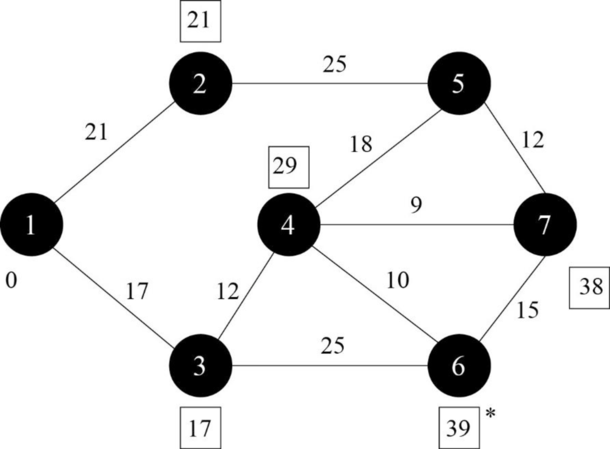
Step 6:

In the above table, nodes from Nodes 1, 3, 2, 4, 7, and 6 (as Node 6 was chosen in step 5) should be considered. However, the chosen branch should not be considered again. While comparing the distance of each branch, 2-5 has the minimum distance. Hence, it was chosen. The final node of the shortest route is Node 5 after Node 1, Node 3, Node 2, Node 4, Node 7, and Node 6 (all the given nodes were chosen for the shortest route). Hence, the steps should be stopped here. The diagram for the above table is as follows:
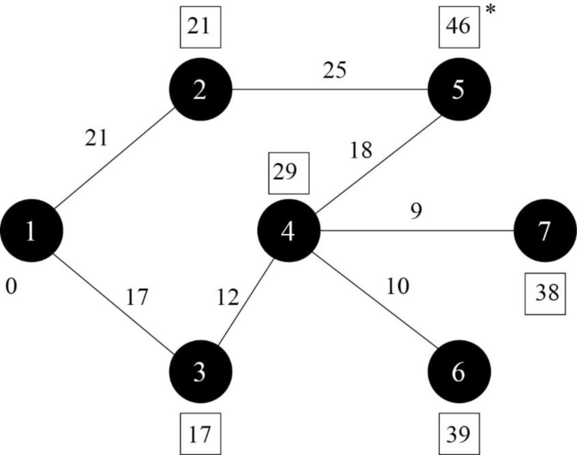
Formulae to determine each distance from step 1 to step 6:
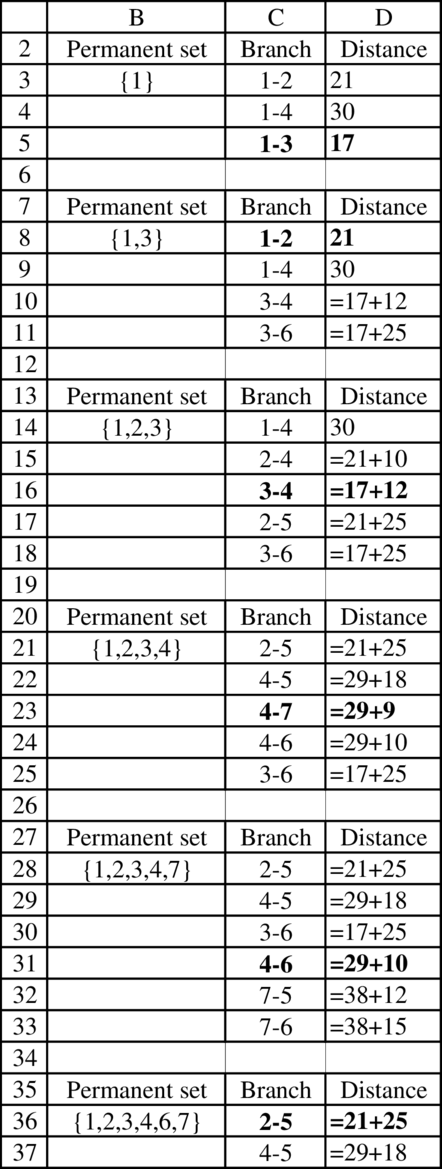
Final diagram and the shortest route:
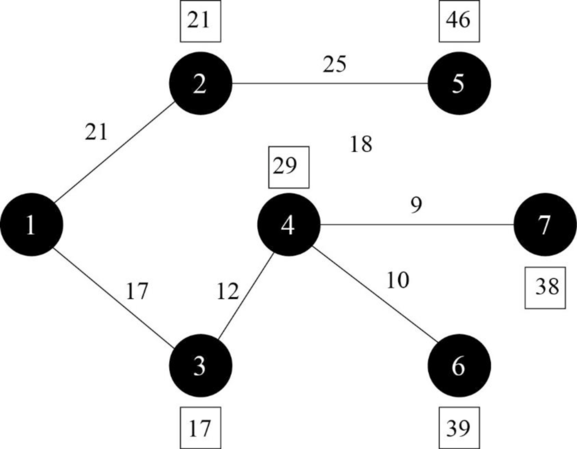
Hence, the shortest route should have the following branches:
1-3, 1-2, 3-4, 4-7, 4-6, and 2-5
Want to see more full solutions like this?
Chapter 7 Solutions
Pearson eText for Introduction to Management Science -- Instant Access (Pearson+)
- Please and thank youarrow_forwardA local fast-food restaurant processes several customer orders at once. Service clerks’ cross paths, sometimes nearly colliding, while they trace different paths to fill customer orders. If customers order a special combination of toppings on their burgers, they must wait quite some time while the special order is cooked. How would you modify the restaurant’s operations to achieve competitive advantage? Because demand surges at lunchtime, volume flexibility is a competitive priority in the fast-food business. How would you achieve volume flexibility? What are the potential downsides of relying too heavily on automation and standardization in this industry? What data would you want to gather, if any, before making recommendations?arrow_forwardWhat are 4 key points that are interesting about this video https://youtu.be/LAoMuvYZ_QM?si=Mognj_KBU9EIOLSParrow_forward
- a) Select all of the correct impacts the maturing of a product might have on OM strategy below. (Check all that apply.) A. Cost cutting is instituted. B. Inventory needs to be revised. C. Labor skills decrease. D. Product design needs to be revised. E. Design compromises are instituted. F. New human resources skills.arrow_forwardPlease help! Multifactor!arrow_forwardKlassen Toy Company, Inc., assembles two parts (parts 1 and 2): Part 1 is first processed at workstation A for 10 minutes per unit and then processed at workstation B for 20 minutes per unit. Part 2 is simultaneously processed at workstation C for 12 minutes per unit. Work stations B and C feed the parts to an assembler at workstation D, where the two parts are assembled. The time at workstation D is 15 minutes. a) The bottleneck of this process is at minutes per unit (enter your response as a whole number).arrow_forward
- Just HELParrow_forwardI need help with C. I'm strugglingarrow_forwardBy signaling their willingness to share information about their interests, but not their BATNA, a negotiator can capitalize on the powerful principle of reciprocity. Which of the following situations best illustrates the reciprocity principle? Group of answer choices A. A car salesman shares information about the town where he grew up, and his custo.mer shares that he also grew up near that town B. A cab driver takes a customer to her hotel and picks up a new customer at the hotel. C. A woman compliments a friend about her purse and the friend says thank you. D. An employee shares information about a project's progress with a coworker who is uncertain.arrow_forward
- What benefits can negotiators get from using the strategy of multiple equivalent simultaneous offers (MESOs)? Give a real life example.arrow_forwardWhat benefits can negotiators get from using the strategy of multiple equivalent simultaneous offers (MESOs)?arrow_forwardWhat is the Perspective on Research? How is the Research from a Biblical perspective conducting Business? What is the connection between Biblical principles and the concepts chosen for conducting Business Research? What is the Perspective on Research? How is the Research from a Biblical perspective conducting Business? What is the connection between Biblical principles and the concepts chosen for conducting Business Research? What is the Perspective on Research? How is the Research from a Biblical perspective conducting Business? What is the connection between Biblical principles and the concepts chosen for conducting Business Research?arrow_forward
 Practical Management ScienceOperations ManagementISBN:9781337406659Author:WINSTON, Wayne L.Publisher:Cengage,
Practical Management ScienceOperations ManagementISBN:9781337406659Author:WINSTON, Wayne L.Publisher:Cengage, Operations ManagementOperations ManagementISBN:9781259667473Author:William J StevensonPublisher:McGraw-Hill Education
Operations ManagementOperations ManagementISBN:9781259667473Author:William J StevensonPublisher:McGraw-Hill Education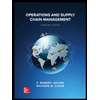 Operations and Supply Chain Management (Mcgraw-hi...Operations ManagementISBN:9781259666100Author:F. Robert Jacobs, Richard B ChasePublisher:McGraw-Hill Education
Operations and Supply Chain Management (Mcgraw-hi...Operations ManagementISBN:9781259666100Author:F. Robert Jacobs, Richard B ChasePublisher:McGraw-Hill Education
 Purchasing and Supply Chain ManagementOperations ManagementISBN:9781285869681Author:Robert M. Monczka, Robert B. Handfield, Larry C. Giunipero, James L. PattersonPublisher:Cengage Learning
Purchasing and Supply Chain ManagementOperations ManagementISBN:9781285869681Author:Robert M. Monczka, Robert B. Handfield, Larry C. Giunipero, James L. PattersonPublisher:Cengage Learning Production and Operations Analysis, Seventh Editi...Operations ManagementISBN:9781478623069Author:Steven Nahmias, Tava Lennon OlsenPublisher:Waveland Press, Inc.
Production and Operations Analysis, Seventh Editi...Operations ManagementISBN:9781478623069Author:Steven Nahmias, Tava Lennon OlsenPublisher:Waveland Press, Inc.





